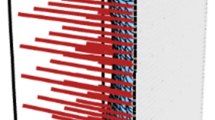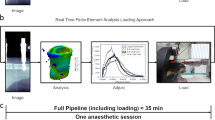Abstract
Computational models in biomechanics are generally unable to incorporate mechanical and anatomical data over the entire range of relevant spatial scales. This chapter proposes the construction of a framework, which unites several methodologies that operate on traditionally different aspects of bone remodelling, bridging the gap between previously incompatible data. The presented framework is used to solve the load adaptation response of the femoral neck as an application and consists of passing data from different sources across a multitude of spatial scales to solve for both organ-level and Haversian-level biomechanical states. The solutions are then stored in a database, to be utilised by a statistical method which can quickly estimate new load adaptation responses for which solutions were not previously generated, cutting down computation time.
Access this chapter
Tax calculation will be finalised at checkout
Purchases are for personal use only
Similar content being viewed by others
References
Frost HM (2000) The Utah paradigm of skeletal physiology: an overview of its insights for bone, cartilage and collagenous tissue organs. J Bone Miner Metab 18(6):305–316
Fernandez JW, Das R, Cleary PW, Hunter PJ, Thomas CD, Clement JG (2013) Using smooth particle hydrodynamics to investigate femoral cortical bone remodelling at the Haversian level. Int J Numer Methods Biomed Eng 29(1):129–143. https://doi.org/10.1002/cnm.2503
McNamara LM, Prendergast PJ (2007) Bone remodelling algorithms incorporating both strain and microdamage stimuli. J Biomech 40(6):1381–1391. https://doi.org/10.1016/j.jbiomech.2006.05.007
Beaupre GS, Orr TE, Carter DR (1990) An approach for time-dependent bone modeling and remodeling-application: a preliminary remodeling simulation. J Orthop Res: Off Publ Orthop Res Soc 8(5):662–670. https://doi.org/10.1002/jor.1100080507
Coelho PG, Fernandes PR, Rodrigues HC, Cardoso JB, Guedes JM (2009) Numerical modeling of bone tissue adaptation—a hierarchical approach for bone apparent density and trabecular structure. J Biomech 42(7):830–837. https://doi.org/10.1016/j.jbiomech.2009.01.020
Pivonka P, Buenzli PR, Scheiner S, Hellmich C, Dunstan CR (2013) The influence of bone surface availability in bone remodelling—a mathematical model including coupled geometrical and biomechanical regulations of bone cells. Eng Struct 47:134–147. https://doi.org/10.1016/j.engstruct.2012.09.006
Turner AW, Gillies RM, Sekel R, Morris P, Bruce W, Walsh WR (2005) Computational bone remodelling simulations and comparisons with DEXA results. J Orthopaed Res : Off Publ Orthop Res Soc 23(4):705–712. https://doi.org/10.1016/j.orthres.2005.02.002
Hambli R, Katerchi H, Benhamou CL (2011) Multiscale methodology for bone remodelling simulation using coupled finite element and neural network computation. Biomech Model Mechanobiol 10(1):133–145. https://doi.org/10.1007/s10237-010-0222-x
White AA, Panjabi MM (1990) Clinical biomechanics of the spine, 2nd edn. Lippincott, Philadelphia
Wang X, Thomas CD, Clement JG, Das R, Davies H, Fernandez JW (2015) A mechanostatistical approach to cortical bone remodelling: an equine model. Biomech Model Mechanobiol 15(1):29–42. https://doi.org/10.1007/s10237-015-0669-x
Ackerman MJ, Spitzer VM, Scherzinger AL, Whitlock DG (1995) The Visible Human data set: an image resource for anatomical visualization. Medinfo. MEDINFO 8(Pt 2):1195–1198
Bell KL, Loveridge N, Power J, Garrahan N, Meggitt BF, Reeve J (1999) Regional differences in cortical porosity in the fractured femoral neck. Bone 24(1):57–64
Sartori M, Reggiani M, Lloyd DG, Pagello E (2011) A neuromusculoskeletal model of the human lower limb: towards EMG-driven actuation of multiple joints in powered orthoses. In: IEEE international conference on rehabilitation robotics [proceedings] 2011, 5975441 (2011). https://doi.org/10.1109/icorr.2011.5975441
Gray H (1918) Anatomy of the human body, 20th edn. Lea & Febiger, Philadelphia
Shinohara M, Sabra K, Gennisson JL, Fink M, Tanter M (2010) Real-time visualization of muscle stiffness distribution with ultrasound shear wave imaging during muscle contraction. Muscle Nerve 42(3):438–441. https://doi.org/10.1002/mus.21723
Herzog W (2000) Skeletal muscle mechanics: from mechanisms to function. Wiley, Chichester
Smit TH, Huyghe JM, Cowin SC (2002) Estimation of the poroelastic parameters of cortical bone. J Biomech 35(6):829–835
Hayes WC, Keer LM, Herrmann G, Mockros LF (1972) A mathematical analysis for indentation tests of articular cartilage. J Biomech 5(5):541–551
Brown TD, Ferguson AB Jr (1980) Mechanical property distributions in the cancellous bone of the human proximal femur. Acta Orthop Scand 51(3):429–437
U.S. FDA Cellular Tissue and Gene Therapies Advisory Committee: Meeting #38 (2005) Cellular products for joint surface repair briefing document. In: U.S. Food and Drug Administration (ed) Rockville, MD
Keller TS, Mao Z, Spengler DM (1990) Young’s modulus, bending strength, and tissue physical properties of human compact bone. J Orthopaed Res Off Publ Orthopaed Res Soc 8(4):592–603. https://doi.org/10.1002/jor.1100080416
Lee WR (1964) Appositional bone formation in canine bone: a quantitative microscopic study using tetracycline markers. J Anat 98:665–677
Davies HMS (1995) The adaptive response of the equine metacarpus to locomotory stress. PhD Thesis, University of Melbourne
Wold S, Sjostrom M, Eriksson L (2001) PLS-regression: a basic tool of chemometrics. Chemometr Intell Lab 58(2):109–130. https://doi.org/10.1016/S0169-7439(01)00155-1
Martelli S (2017) Femoral neck strain during maximal contraction of isolated hip-spanning muscle groups. Comput Math Method Med 2017:2873789. https://doi.org/10.1155/2017/2873789
Author information
Authors and Affiliations
Corresponding author
Editor information
Editors and Affiliations
Rights and permissions
Copyright information
© 2020 Springer Nature Switzerland AG
About this chapter
Cite this chapter
Wang, X., Fernandez, J. (2020). A Mechanostatistical Approach to Multiscale Computational Bone Remodelling. In: Belinha, J., Manzanares-Céspedes, MC., Completo, A. (eds) The Computational Mechanics of Bone Tissue. Lecture Notes in Computational Vision and Biomechanics, vol 35. Springer, Cham. https://doi.org/10.1007/978-3-030-37541-6_6
Download citation
DOI: https://doi.org/10.1007/978-3-030-37541-6_6
Published:
Publisher Name: Springer, Cham
Print ISBN: 978-3-030-37540-9
Online ISBN: 978-3-030-37541-6
eBook Packages: Biomedical and Life SciencesBiomedical and Life Sciences (R0)




